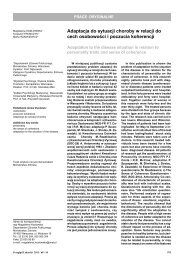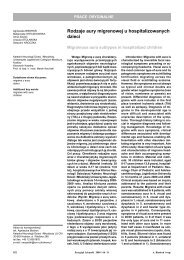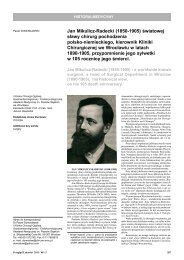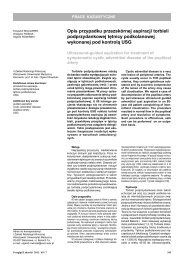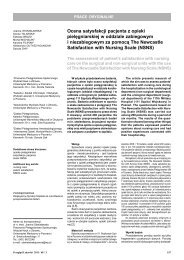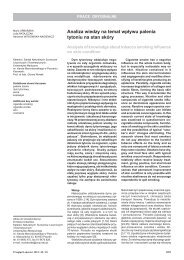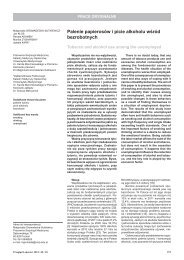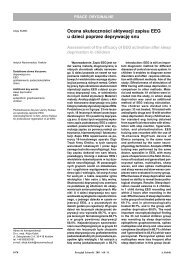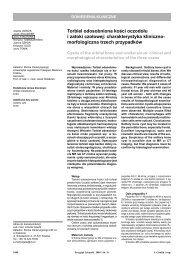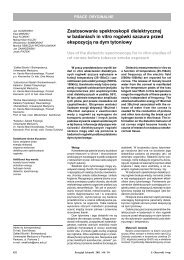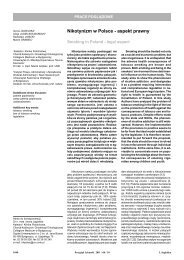Wzorzec-przegl d lekarski-XX-2001
Wzorzec-przegl d lekarski-XX-2001
Wzorzec-przegl d lekarski-XX-2001
You also want an ePaper? Increase the reach of your titles
YUMPU automatically turns print PDFs into web optimized ePapers that Google loves.
ORIGINAL PAPERS – PRACE ORYGINALNE<br />
Sara ARBER<br />
Gender, marital status and sleep problems<br />
in Britain<br />
P³eæ, stan cywilny i problemy ze snem<br />
w Wielkiej Brytanii<br />
Department of Sociology, University of Surrey,<br />
Guildford, Surrey<br />
Co-Director, Centre for Research on Ageing<br />
and Gender (CRAG): Professor Sara Arber<br />
Additional key words:<br />
sleep problems<br />
gender<br />
marital status<br />
socio-economic status (SES)<br />
Dodatkowe s³owa kluczowe:<br />
problemy ze snem<br />
p³eæ<br />
status cywilny<br />
status spo³eczno-ekonomiczny<br />
Professor Sara Arber<br />
Co-Director, Centre for Research on Ageing<br />
and Gender (CRAG),<br />
Department of Sociology, University of Surrey,<br />
Guildford, Surrey GU2 7XH<br />
Tel: 01483-686973; Fax: 0441483-689551<br />
Email: S.Arber@surrey.ac.uk<br />
Sleep is fundamental to health and<br />
well-being, with women consistently<br />
reporting greater sleep problems than<br />
men, yet scant sociological research<br />
has examined gender differences in<br />
sleep quality. This paper analyses (i)<br />
gender differences in sleep problems,<br />
and (ii) how marital status differences<br />
in sleep problems differ among women<br />
and men. In both cases, the relative<br />
contributions of socio-economic status<br />
(SES), smoking, worries, health<br />
and depression in explaining these<br />
gender and marital status differences<br />
are analysed. Logistic regression is<br />
used to analyse the British Psychiatric<br />
Morbidity Survey 2000, which interviewed<br />
8578 men and women aged 16 to<br />
74. Women reported significantly more<br />
sleep problems than men, as did the<br />
divorced and widowed compared with<br />
married respondents. Gender differences<br />
in sleep problems were halved following<br />
adjustment for socio-economic<br />
characteristics, suggesting that SES<br />
inequalities play a major part in accounting<br />
for gender differences. This study<br />
casts doubt on the primacy of physiological<br />
explanations underlying<br />
gender differences in sleep. Marital<br />
status differences in sleep are greater<br />
among men than women, with previously<br />
partnered men reporting particularly<br />
poor quality sleep. However, this<br />
is largely explained by the more disadvantaged<br />
socio-economic circumstances<br />
of the previously partnered,<br />
especially for men. The paper concludes<br />
that gender and marital status differences<br />
are partly due to the lower<br />
socio-economic status of women and<br />
of the previously partnered.<br />
Sen jest podstawowym wyznacznikiem<br />
zdrowia i samopoczucia, kobiety<br />
konsekwentnie podaj¹ wiêcej problemów<br />
ze snem ni¿ mê¿czyŸni, dot¹d<br />
niewiele badañ socjologicznych analizowa³o<br />
genderowe ró¿nice w jakoœci<br />
snu. Artyku³ ten analizuje 1/genderowe<br />
ró¿nice w odniesieniu do problemów<br />
ze snem, 2/ próbuje wskazaæ jak<br />
stan cywilny ró¿nicuje problemy ze<br />
snem kobiet i mê¿czyzn. W obu przypadkach<br />
wp³yw statusu spo³ecznoekonomicznego<br />
(SSE), palenie tytoniu,<br />
zmartwienia, stan zdrowia i depresja<br />
by³y analizowane dla wyjaœnienia tych<br />
ró¿nic wynikaj¹cych z p³ci i stanu cywilnego.<br />
Model regresji logistycznej<br />
zosta³ zastosowany dla przeanalizowania<br />
wyników British Psychiatric Morbidity<br />
Survey 2000, w którym przeprowadzono<br />
wywiady z 8578 mê¿czyzn i<br />
kobiet w wieku 16 do 74 lat. Kobiety<br />
zg³asza³y istotnie wiêcej problemów ze<br />
snem ni¿ mê¿czyŸni, tak jak osoby rozwiedzione<br />
i owdowia³e w porównaniu<br />
do respondentów pozostaj¹cych w<br />
zwi¹zkach ma³¿eñskich. Ró¿nice genderowe<br />
w problemach ze snem wystandaryzowane<br />
w odniesieniu do statusu<br />
spo³eczno-ekonomicznego sugeruj¹,<br />
¿e nierównoœci wynikaj¹ce z statusu<br />
spo³eczno-ekonomicznego odgrywaj¹<br />
g³ówn¹ rolê w okreœlaniu ró¿-<br />
nic genderowych. To badanie zasia³o<br />
w¹tpliwoœæ oddawania pierwszeñstwa<br />
fizjologicznemu wyjaœnianiu tych ró¿-<br />
nic genderowych. Ró¿nice w œnie zale¿ne<br />
od stanu cywilnego s¹ wiêksze<br />
wœród mê¿czyzn ni¿ wœród kobiet,<br />
mê¿czyŸni ,którzy byli poprzednio w<br />
zwi¹zkach szczególnie zwracali uwagê<br />
na z³¹ jakoœæ snu. Jakkolwiek, by³y<br />
one w wiêkszoœci wyjaœniane przez<br />
wiêcej niekorzystnych uwarunkowañ<br />
zwi¹zanych ze statusem spo³ecznoekonomicznym<br />
mê¿czyzn poprzednio<br />
przebywaj¹cych w zwi¹zkach. Wnioski<br />
wskazuj¹ na fakt, ¿e ró¿nice genderowe<br />
i wynikaj¹ce ze stanu cywilnego s¹<br />
czêœciowo zale¿ne od niskiego statusu<br />
spo³eczno-ekonomicznego kobiet i<br />
od przebywania poprzednio w zwi¹zku.<br />
54 Przegl¹d Lekarski 2012 / 69 / 2 S. Arber
Introduction<br />
Social scientists have paid relatively little<br />
attention to quality of sleep, nor have they<br />
assessed whether social factors mediate<br />
gender differences in sleep quality. This<br />
paper examines the British Psychiatric Morbidity<br />
Survey [28] to better understand gender<br />
and marital status differences in sleep<br />
problems.<br />
It is well-known in sleep research that<br />
women report higher levels of sleep complaints<br />
than men [16, 26, 33]. A meta-analysis<br />
of 29 published studies concluded that<br />
the overall risk ratio of insomnia was 1.41<br />
for women compared to men [33]. Biological<br />
or physiological sex differences are often<br />
identified as explanations for women's<br />
higher levels of disturbed sleep [4,7,19], and<br />
psychological explanations are also prevalent<br />
[19]. Women have higher levels of depression<br />
and anxiety, and research shows<br />
that individuals suffering from psychiatric<br />
disorders, such as depression and anxiety,<br />
have poorer quality sleep [23,30]. However,<br />
gender differences in sleep quality remain<br />
after removing the effects of women's higher<br />
rates of psychiatric morbidity [19,33].<br />
Studies of gender differences in sleep<br />
less frequently consider sociological explanations.<br />
Chen et al.[4] conclude that 'In contrast<br />
with explanations emphasising gender<br />
differences in biology and prior psychiatric<br />
illnesses, the sociological perspective has<br />
not been well investigated in the existing<br />
literature.' They found that the gender difference<br />
in sleep disturbance was reduced<br />
after controlling for women's social roles<br />
(using marital status, employment status,<br />
and number of children under 15 as a proxy<br />
for childcare responsibilities). However,<br />
women's sleep quality still remained significantly<br />
poorer than men's, suggesting the<br />
need for research on gender differences<br />
using more extensive measures of social<br />
roles and socio-economic status (SES).<br />
Sekine et al. [26] found that the gender difference<br />
in reported sleep quality among<br />
Japanese civil servants could be entirely<br />
explained by gender differences in work<br />
characteristics, domestic roles and familywork<br />
conflicts. However, it remains unclear<br />
whether gender differences can be explained<br />
by socio-economic, work and family<br />
characteristics among nationally representative<br />
population samples.<br />
Other researchers have shown the<br />
poorer sleep quality of the divorced/separated<br />
and of widowed people. However, it<br />
is also important to examine whether there<br />
is a gender and marital status interaction in<br />
relation to sleep quality, rather than simply<br />
analysing gender and marital status as additive<br />
variables within analyses. In particular,<br />
whether there are greater marital status<br />
differences among men than women,<br />
and the reasons underlying any such differences.<br />
Married men have been shown<br />
to be particularly advantaged, regarding a<br />
number of other dimensions of well-being<br />
(including income, material circumstances,<br />
health and social support), with smaller<br />
marital status differences found among<br />
women than among men [1]<br />
A major reason for poorer sleep quality<br />
is because chronic ill-health causes pain and<br />
discomfort at night, resulting in sleep complaints<br />
and disorders [5, 29, 32]. Since poor<br />
physical and mental health is associated<br />
with disrupted sleep it is important to assess<br />
whether gender or marital status differences<br />
in sleep quality are confounded by poorer<br />
health among women and among those who<br />
are previously married.<br />
Materials and Methods<br />
This paper addresses the following research questions:<br />
(1) What is the relative contribution of socio-economic<br />
characteristics, compared with smoking, worries,<br />
poor health and depression, in explaining gender differences<br />
in sleep problems<br />
(2) How does the association between marital status<br />
and sleep problems differ among women and men,<br />
and what is the relative contribution of socio-economic<br />
characteristics and other factors to marital status differences<br />
in sleep problems<br />
The paper analyses a British nationally representative<br />
cross-sectional survey: the 2000 Psychiatric Morbidity<br />
Survey [28]. Home interviews (averaging 1 1/2 hours)<br />
were conducted with 8,580 people aged 16-74. A representative<br />
sample of addresses was selected from the<br />
Postcode Address File with one household member aged<br />
16-74 randomly selected for interview from each sample<br />
household. The response rate of 69.5% is high, considering<br />
the length and complexity of the interview [28, 29].<br />
The maximum age is 74 years, therefore our findings<br />
cannot be generalised to older people above this age.<br />
Sleep Problems<br />
Sleep problems were measured as part of the revised<br />
version of the Clinical Interview Schedule (CIS-R)<br />
[18]. Respondents were asked: 'In the past month, have<br />
you been having problems with trying to get to sleep or<br />
with getting back to sleep if you woke up or were woken<br />
up' Those answering 'Yes', were asked: 'On how many<br />
of the past seven nights did you have problems with your<br />
sleep' Three response categories were provided: None;<br />
1 to 3 nights; 4 nights or more. The paper analyses a<br />
dichotomous variable of reporting sleep problems on 4<br />
or more nights per week (versus less often) as an indicator<br />
of frequently experienced sleep difficulties.<br />
Socio-demographic and socio-economic<br />
characteristics<br />
Age was categorised as 16-24, 25-34, 35-44, 45-<br />
54, 55-64, 65-74.<br />
Marital status - Married/cohabiting, Never married,<br />
Widowed, Divorced/separated. Number of children living<br />
in the household, coded as None, 1, 2, 3 or more.<br />
Highest educational qualifications were coded into<br />
4 ordinal categories: Degree level or higher qualifications;<br />
Professional, teaching, or technical qualifications<br />
and A levels (national examinations taken at 18 and required<br />
for university entry); Lower qualifications, e.g.<br />
GCSE/O levels, secretarial, trade and apprenticeship<br />
qualifications; and No educational qualifications.<br />
Employment status was self-reported as Full-time<br />
employed, Part-time employed, Unemployed (looking for<br />
work in last 4 weeks) or Economically inactive (coded<br />
from main reason not working in last 4 weeks as retirement,<br />
full-time student, household duties, or disability/<br />
long-term sick).<br />
Housing tenure was coded as Owns accommodation;<br />
Rents from Public Housing (Local Authority or Housing<br />
Association); or Rents from other sources, primarily<br />
private renting.<br />
Household income is measured by the sum of personal<br />
gross income from all sources for each household<br />
member, equivalised using the McClements Scale [6],<br />
which adjusts for differences in number of adults and<br />
children in the household. Income was coded into 5 ranges:<br />
the lowest category (< £ 150 per week) comprises<br />
20% of the whole sample, and the highest (> £ 750 per<br />
week) comprises 12%.<br />
Measures of other variables<br />
Smoking was categorised as Never smoked, Exsmoker<br />
and Current smoker.<br />
Worries. Self-reported data about Worries (in general),<br />
Worries about health, and Depression were obtained<br />
using the CIS-R symptom scores [18]. For each<br />
of these measures, interviewees were asked if they had<br />
experienced 4 different symptoms in the last 7 days. In<br />
each case, this was scored as None, Medium (1 symptom<br />
reported), and High (2 or more symptoms reported).<br />
Self-rated (or self-assessed) health is used extensively<br />
in research on determinants of health, and is a<br />
good predictor of mortality and general health [8,14]. Selfrated<br />
health was measured by asking: 'How is your health<br />
in general Would you say your health is Excellent, Very<br />
Good, Good, Fair or Poor', recoded into 3 categories:<br />
Very good (representing 'excellent' or 'very good'), Good,<br />
and Poor (representing 'fair' or 'poor').<br />
Number of chronic illnesses was measured by asking;<br />
'Do you have any long-standing illnesses, disability<br />
or infirmity By long-standing I mean anything that has<br />
troubled you over a period of time or that is likely to affect<br />
you over a period of time.' Respondents self-reporting<br />
'Yes', were asked 'What is the matter with you' and<br />
each health problem mentioned was recorded. The total<br />
number of long-standing health problems self-reported<br />
were summed, and recoded as None, 1, 2, 3 or more.<br />
Statistical analysis<br />
The proportions of men and women reporting sleep<br />
problems on 4 or more nights a week are analysed for<br />
each of the above variables, with chi-squared probability<br />
values reported (Tables 1-2). Hierarchical logistic regression<br />
models are presented to examine the two research<br />
questions addressed in the paper.<br />
Statistical analyses were performed using SPSS<br />
(version 13, SPSS, Inc., Chicago, IL). Statistical tests<br />
used .05 (2 tailed) significance levels. To allow the<br />
strength and precision of the relationships to be assessed,<br />
results are presented as odds ratios (OR) with<br />
their associated 95% confidence intervals (CI).<br />
Results<br />
Gender differences in sleep problems<br />
- bivariate analyses<br />
Tables I and II show the proportion of<br />
men and women reporting sleep problems<br />
on 4 or more nights per week in relation to<br />
socio-demographic, socio-economic, health<br />
and other variables. More women (20%)<br />
than men (14%) report sleep problems on 4<br />
or more nights per week. A significant relationship<br />
with age is found for women but not<br />
for men. The highest proportion of women<br />
reporting sleep problems are age 45-54<br />
(24%) with a modest decline above this age.<br />
The divorced/separated report the worst<br />
sleep among both women (27%) and men<br />
(26%), followed by the widowed (26%<br />
women, 21% men). The gender difference<br />
in sleep problems is greater among married<br />
people (18% of married women and 12.5%<br />
married men report sleep problems), than<br />
among the single (16% vs 12%), or divorced.<br />
This suggests that the sleep advantage of<br />
marriage may be primarily experienced by<br />
married men, rather than married women,<br />
which would accord with results from a<br />
range of qualitative studies [13,31].<br />
Significant associations with sleep problems<br />
are found for each socio-economic status<br />
(SES) measure, which are broadly comparable<br />
for men and women. Regarding<br />
household income, only 10% in the highest<br />
income group report sleep problems compared<br />
with 25% in the lowest income group.<br />
Adults with more education report fewer<br />
sleep problems; only 12% with a degree report<br />
sleep problems compared with 22%<br />
who have no qualifications. The unemployed<br />
(22%) and economically inactive (25%) are<br />
more likely than the full-time employed<br />
Przegl¹d Lekarski 2012 / 69 / 2<br />
55
2<br />
1,8<br />
Figure 1<br />
Odds Ratios of Women having Poor Sleep Quality<br />
on 4 or more nights per week, compared with the<br />
Men (reference category, men = 1.0) a .<br />
1,6<br />
1,4<br />
1,2<br />
1<br />
1.49**<br />
1.42**<br />
1.23**<br />
1.17*<br />
1.27**<br />
1. Age<br />
2. + Marital Status, children<br />
3. + Socioeconomic<br />
4. + Worries/Smoking<br />
5. + Health<br />
a. Hierarchical logistic regression models adjusting for<br />
sets of variables, as in Table III. Model 1, Age; Model 2,<br />
+ Marital Status, Number of Children; Model 3, +<br />
Socioeconomic (Educational Qualifications, Employment<br />
Status, Household Income, Housing Tenure); Model 4,<br />
+ Worries, Smoking; Model 5, + Subjective health, Health<br />
worries, Number of chronic illnesses, Depressive<br />
symptoms.<br />
Significance of gender difference, ** p
£<br />
Table I<br />
Proportion reporting poor sleep on 4 or more nights a week by demographic and socio-economic variables<br />
by gender, age 16-74<br />
Men<br />
Women<br />
Total<br />
% n = % N = % n=<br />
All<br />
14.<br />
2 3851<br />
19.<br />
7 4727<br />
17.<br />
2 8578<br />
Age<br />
16-24<br />
10.<br />
9 385<br />
15.<br />
9 409<br />
13.<br />
5 794<br />
25-34<br />
12.<br />
9 711<br />
15.<br />
7 972<br />
14.<br />
6 1683<br />
35-44<br />
13.<br />
2 823<br />
17.<br />
5 1024<br />
15.<br />
6 1847<br />
45-54<br />
15.<br />
1 747<br />
24.<br />
2 798<br />
19.<br />
8 1545<br />
55-64<br />
16.<br />
7 646<br />
22.<br />
0 796<br />
19.<br />
6 1442<br />
65-74<br />
15.<br />
4 539<br />
22.<br />
9 728<br />
19.<br />
7 1267<br />
p=<br />
0.091<br />
0.000<br />
0.000<br />
Marital Status<br />
Married<br />
12.<br />
5 2356<br />
18.<br />
0 2739<br />
15.<br />
5 5095<br />
Single<br />
12.<br />
4 937<br />
15.<br />
8 849<br />
14.<br />
0 1786<br />
Widowed<br />
21.<br />
4 131<br />
25.<br />
9 432<br />
24.<br />
9 563<br />
Divorced/Separated<br />
25.<br />
5 427<br />
27.<br />
2 707<br />
26.<br />
5 1134<br />
p=<br />
0.000<br />
0.000<br />
0.000<br />
Number of children<br />
No<br />
children<br />
15.<br />
2 2816<br />
20.<br />
4 3096<br />
17.<br />
9 5912<br />
1 child<br />
13.<br />
2 440<br />
19.<br />
1 650<br />
16.<br />
7 1090<br />
2 children<br />
9.<br />
3 454<br />
18.<br />
5 701<br />
14.<br />
9 1155<br />
3+<br />
children<br />
13.<br />
5 141<br />
16.<br />
4 280<br />
15.<br />
4 421<br />
p=<br />
0.008<br />
0.303<br />
0.055<br />
Highest Educational Qualifications<br />
Degree<br />
9.<br />
4 662<br />
14.<br />
7 577<br />
11.<br />
9 1239<br />
Professional,<br />
A Level<br />
10.<br />
7 857<br />
17.<br />
2 886<br />
14.<br />
0 1743<br />
GCSE<br />
or equivalent<br />
15.2 1 2 1248<br />
17.<br />
9 1719<br />
16.<br />
8 2967<br />
No<br />
qualifications<br />
18.<br />
7 1047<br />
25.<br />
1 1517<br />
22.<br />
5 2564<br />
p=<br />
0.000<br />
0.000<br />
0.000<br />
Employment Status<br />
Working<br />
full time<br />
10.<br />
2 2353<br />
14.<br />
5 1463<br />
11.<br />
8 3816<br />
Working<br />
part time<br />
11.<br />
6 285<br />
16.<br />
0 1168<br />
15.<br />
1 1453<br />
Unemployed<br />
20.<br />
5 146<br />
24.<br />
6 114<br />
22.<br />
3 260<br />
Economically<br />
inactive<br />
23.<br />
1 1031<br />
25.<br />
5 1954<br />
24.<br />
7 2985<br />
p=<br />
0.000<br />
0.000<br />
0.000<br />
Household Equivalised Income per week L£<br />
< L150 £<br />
24.<br />
9 574<br />
25.<br />
7 1082<br />
25.<br />
4 1656<br />
£ L150
Table II<br />
Proportion reporting poor sleep on 4 or more nights a week by smoking, worries and health variables by<br />
gender, age 16-74<br />
Men Women Total<br />
% n= % n= % n=<br />
Cigarette Smoking<br />
Current Smoker 19.0 1162 24.4 1402 22.0 2564<br />
Ex Smoker 12.0 1808 18.3 1938 15.3 3746<br />
Never Smoked 12.3 877 16.8 1383 15.0 2260<br />
p= 0.000 0.000 0.000<br />
Self-reported Worries<br />
No 9.3 2612 12.5 2888 11.0 5500<br />
Medium 14.6 591 22.2 825 19.0 1416<br />
High 33.6 648 38.4 1014 36.5 1662<br />
p= 0.000 0.000 0.000<br />
Health worries<br />
No 10.0 3228 15.3 3909 12.9 7137<br />
Medium 28.4 342 33.7 466 31.4 808<br />
High 45.6 281 49.7 352 47.9 633<br />
p= 0.000 0.000 0.000<br />
Self-reported Health<br />
Very Good or Excellent 7.0 2111 12.3 2473 9.8 4584<br />
Good 13.4 972 20.4 1253 17.3 2225<br />
Fair or poor 35.1 767 37.4 999 36.4 1766<br />
p= 0.000 0.000 0.000<br />
Number of chronic illnesses<br />
0 8.3 2108 12.7 2442 10.7 4550<br />
1 16.7 1099 21.4 1296 19.2 2395<br />
2 22.0 381 28.7 575 26.0 956<br />
3 or more 40.0 260 44.0 411 42.5 671<br />
p= 0.000 0.000 0.000<br />
Source: Psychiatric Morbidity Survey, 2000 (authors' analysis)<br />
Worries are implicated in the gender difference<br />
in sleep problems. Women's sleep<br />
is more likely to be disturbed by worries,<br />
particularly associated with their gender role<br />
as mothers or wives, and their concern for<br />
the well-being of family members [13, 2, 31].<br />
Previous sleep research has tended to view<br />
'worries' as a mark of anxiety or psychological<br />
problems, rather than embedded within<br />
social roles and responsibilities. Worries<br />
and concerns represent an important predictor<br />
of sleep problems, but retain an independent<br />
effect after controlling for health and<br />
depression Table III, Model 5). In addition,<br />
this analysis suggests that differences in<br />
health status between men and women do<br />
not explain the gender difference in sleep<br />
problems. Indeed, the gender difference<br />
becomes greater after adjusting for health<br />
variables and depression (Table III, Model 5).<br />
This research supports other studies<br />
that have found poorer sleep quality among<br />
those with low educational qualifications [15,<br />
21, 24, 29], who are not working [22, 24],<br />
and have low income [17, 9]. However, this<br />
study goes beyond previous research in two<br />
ways. First, by using representative national<br />
data to simultaneously consider the independent<br />
effects of four SES variables (education,<br />
employment status, household income,<br />
housing tenure). Second, it addresses previous<br />
observations [24] that the higher prevalence<br />
of insomnia among individuals with low<br />
education, not working and with low income<br />
may be confounded by poor physical and<br />
mental health, through examining models<br />
containing health measures and depression.<br />
The relative importance of different sets<br />
of factors in leading to sleep problems are<br />
considered. 'Worries' are likely to be confounded<br />
with socio-economic characteristics;<br />
the relationships between sleep problems<br />
and living on a low income or living in rented<br />
housing were partially mediated through<br />
worries and concerns. After adjusting for<br />
smoking, worries, health and depression, a<br />
significant independent association still remained<br />
between sleep problems and both<br />
low education and not being in paid work.<br />
Lack of employment is linked to sleep problems<br />
in two ways; for the unemployed, primarily<br />
through its intrinsic relationship with<br />
worries, while for the economically inactive,<br />
primarily because of their poorer health status.<br />
There is a much larger effect of marital<br />
status on sleep problems among men than<br />
among women, suggesting advantages<br />
conferred by marriage for men in terms of<br />
sleep quality. Divorced/separated men and<br />
widowed men have particularly poor quality<br />
sleep compared with married men. Although<br />
losing a partner (whether through<br />
divorce or death) has psychological consequences<br />
which may adversely effect sleep<br />
quality, this analysis shows that a major factor<br />
explaining the higher rate of sleep problems<br />
among the previously married is their<br />
more disadvantaged SES.<br />
Conclusions<br />
A large part of the well-known gender<br />
difference in reported sleep problems is<br />
mediated by the more disadvantaged socioeconomic<br />
status (SES) of women, casting<br />
doubt on the primacy of physiological explanations<br />
of this gender difference. In turn,<br />
SES is shown to impact on psychological<br />
distress and worries, which form part of the<br />
mechanism through which disadvantaged<br />
SES impacts on sleep problems.<br />
There are gender differences in the association<br />
of marital status with poor sleep<br />
with greater effects of marital status for men<br />
than women. Men who were previously married<br />
(whether divorced or widowers) have<br />
particularly poor sleep compared with their<br />
married counterparts. Whereas for women,<br />
these associations with marital status are<br />
less strong. However, among both men<br />
and women, a substantial proportion of the<br />
higher reported sleep problems of the divorced<br />
and widowed can be accounted for<br />
by their more disadvantaged SES. These<br />
findings that people with more disadvantaged<br />
SES report greater sleep problems<br />
need further consideration by health researchers.<br />
Despite sleep being important for health<br />
and well-being [3], previous research on<br />
gender inequalities in health has hitherto<br />
paid scant attention to gender differences<br />
in sleep problems or to how women's disadvantaged<br />
social position or gender roles<br />
mediate these differences. This research<br />
has shown strong linkages both between<br />
socio-economic variables and reported<br />
sleep problems, and between health variables<br />
and sleep problems. This suggests<br />
that low socio-economic status, family worries<br />
and women's family roles, may potentially<br />
be mechanisms that account for<br />
women's greater experience of sleep disruption.<br />
Acknowledgements<br />
The author acknowledges funding from<br />
the New Dynamics of Ageing initiative, a<br />
multidisciplinary research programme sup-<br />
58 Przegl¹d Lekarski 2012 / 69 / 2 S. Arber
Table III<br />
Odds Ratios of poor sleep quality on 4 or more nights per week (n= 8240).<br />
Model 1<br />
Age +<br />
Sex<br />
Model 2<br />
+<br />
Demographic<br />
-2 Log likelihood 7481.59 7415.25 7186.16 6711.49 6268.64<br />
Ddf 6 6 12 4 9<br />
Nagelkerke R Square .017 0.030 0.075 0.164 0.242<br />
* p
25. Seeman T., Merkin S.S., Crimmins, E. et al.: Education,<br />
income and ethnic differences in cumulative<br />
biological risk profiles in a national sample of US<br />
adults: NHANES III (1988-1994). Soc. Sci. Med.<br />
2008, 66, 72<br />
26. Sekine M., Chandola T., Martikainen P. et al.: Work<br />
and family characteristics as determinants of socioeconomic<br />
and gender inequalities in sleep: The Japanese<br />
Civil Servants Study. SLEEP 2006, 29, 206.<br />
27. Shishehbor M.H., Litaker D., Pothier C.E., Lauer<br />
M.S.: Association of socio-economic status with functional<br />
capacity, heart rate recovery, and all-cause<br />
mortality. JAMA 2006, 295, 784.<br />
28. Singleton N., Bumpstead R., O'Brien M., Lee A.,<br />
Meltzer H.: Psychiatric Morbidity among Adults living<br />
in Private Households, 2000, Office for National<br />
Statistics, London: The Stationery Office, <strong>2001</strong>.<br />
29. Stewart R., Besset A., Bebbington R. et al.: Insomnia<br />
comorbidity and impact and hypnotic use by<br />
age group in a national survey population aged 16<br />
to 74. SLEEP 2006, 29, 1391<br />
30. Ustun T.B.: Cross-national epidemiology of depression<br />
and gender. J. Gend. Specif. Med. 2000, 3, 54.<br />
31. Venn S., Arber S., Meadows R. Hislop J.: The<br />
Fourth Shift: Exploring the gendered nature of sleep<br />
disruption among couples with children. Br. J. Sociol.<br />
2008, 59, 79.<br />
32. Vitiello M.V., Moe K.E., Prinz P.N.: Sleep complaints<br />
cosegregate with illness in older adults. Clinical research<br />
informed by and informing epidemiological<br />
studies of sleep. J. Psychosom. Res. 2002, 53, 555.<br />
33. Zhang B., Wing Y-K.: Sex differences in insomnia:<br />
A meta-analysis. SLEEP 2006, 29, 85.<br />
60 Przegl¹d Lekarski 2012 / 69 / 2 S. Arber



